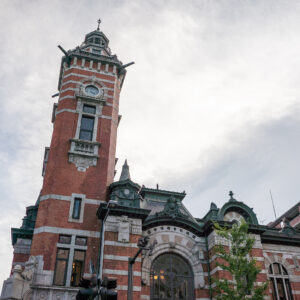The Yokohama Port Opening Memorial Hall is one of three time-honored buildings with towers located in Yokohama. In my earlier blog (LINK), I introduced to you the three, referring to their nicknames (Jack for the Yokohama Port Opening Memorial Hall, King for the Kanagawa Prefectural Government Building, Queen for the Yokohama Custom Office) as well as a folk belief that you will get lucky if you can see the three towers at once. In this blog, let me talk more about the Yokohama Port Opening Memorial Hall with some historical stories about Yokohama where I live.


The construction of Yokohama Port Opening Memorial Hall was completed in 1917 as one of activities to commemorate the 50th anniversary of the opening of the Yokohama Port. All the construction costs were covered by donation from citizen living in Yokohama and the building has been serving as a town hall since then. The building houses small and big conference rooms, and an auditorium with a seating capacity of 200 people. It boasts of such architectural characteristics as a 36-meter-high clock tower and decorations including magnificent stained glasses.


Pawhatan is the name of a ship depicted in a stained glass at a stair landing of the Yokohama Port Opening Memorial Hall. She was a sidewheel steam frigate in the United States Navy which symbolizes the opening of the Yokohama Port. Today, Yokohama is one of major cities in Japan with a population of 3.8 million and the Yokohama International Port is one of key maritime-transportation hubs in Asia. But Yokohama used to be a very small village until its port opening to the West in 1859. USS Pawhatan entered the Edo (old Tokyo) Bay in 1854 as one of the fleet led by US Navy Admiral Perry and remained as a symbol of the force until the Japan-US Treaty of Peace and Amity was signed. The treaty stipulated opening ports to US and with similar treaties concluded later with other Western nations, the Yokohama port and other four were opened in 1859, which put an end to Japan’s 260-year-long seclusion policy which started in the bigging of the 17th century. Since then, Yokohama was developing as an international port and many foreign people from the west and Asian countries settled in the city, enhancing cross-cultural exchange and creating an unique culture of Yokohama, an integration of the East and the West cultures.



“GO-ETSU DOSHU” and “Travel to Hakone”
These stained glasses are placed at a hall on the 2nd floor. A stained glass on the left is said to describe “GO-ETU DOSHU”, a Chinese legend that bitter enemies (GO and ETSU) happened to share the same boat (DOSHU) and they were forced to manage a rolling boat in a storm together for survival despite their hostility. Although GO-ETSU DOSHU is such a legend from China, interestingly, people in the stained glass look very calm with no hostility shown on their faces. They seem travelling in a scenic spot in Japan adorned with Japanese pine trees. The waterman is apparently a Japanese. Does this stained glass suggest that any enemies should be able to stop their fight while they stay in Yokohama and Japan?
A stained glass on the right is depicting “Travel to Hakaone”. Hakone is to the west of Yokohama, about 70km away, being one of very popular tourist destinations from the past because of its many attractions including a closer look at Mt.Fuji. Actually the mountain is put atop in the stained glass. Hakone used to be regarded as a hard place to travel because of its mountainous terrain. As such, in the stained glass, westerners hired and sat on “KAGO”, a palanquin carried by Japanese bearers.
The Yokohama Port Opening Memorial Hall is located in a time-honored business district of Yokohama, being very close to other port facilities like “Ohsanbashi Pier” (one of the biggest piers in Japan) and “Red Brick Warehouse” (a historical warehouse, now renovated to shopping and dining facilities).
I’d be more than happy to guide you to the hall and other attractions in the Yokohama Port!
By Jin Shibata
Email: jin.shibata@i3ws.co.jp

Comment